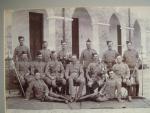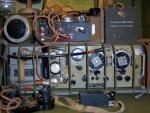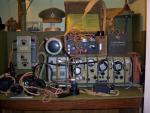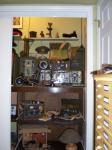-
Posts
6,486 -
Joined
-
Last visited
-
Days Won
10
Content Type
Profiles
Forums
Blogs
Gallery
Events
Store
Everything posted by Brian Wolfe
-
Hello Olsen364, The antenna itself is the standard base for the WS19 and other radios of the period and comes up for auction on eBay from time to time. The steel guard is not an original. After years of looking and attending restoration fairs I finally had one of the mechanics where I work make one up. I was told by a fellow I met at a swap meet that these were often made up "in the field" and then attached to the vehicle. I can find no evidence to support his statement but he certainly seemed to know what he was talking about and he seemed to have everything on his table except what I was looking for. Sorry I can't point you in the right direction for an authentic guard. The antenna base with the rubber fitting has no numbers but they are fairly common as is the antenna itself. The antenna on the right hand side is actually a length of automotive break line that I painted the correct colour. This is what many restorers used and it actually works quite well for them. I hope this is of some help. Regards Brian
-
Hello Everyone, Here is a photo of two howitzer sections of the late Victorian era, 1901-1902. With the help of several knowledgeable collectors who are not members of the GMIC I have completed the research and offer the findings here. This is most likely an artillery training school photo. The frock worn by the seated officer is as per DR 1900, the o/r's frocks are as per issue of the late Victorian era though two have scalloped flaps, all have stand collars. These variations were typical, as were some issues of the field service cap with a single button. From the shoulder badges there is no doubt that these are Royal Artillery. The soldier reclining in the front right of the section has an "L" patch on his sleeve indicating that he is a gun layer. The two privates in the rear are holding sight/sliding level deflection tools while the oval cases on their pre-1903 belts hold Clinometers. A clinometer was used to measure inclines as well as determining the height of objects. The buckle on the '03 belt has rounded edges, these are squared and typical of RA stationed in India. The two seated corporals wear the shoulder belts to accomodate the sight, level/deflection tool which would be entrusted to them as opposed to the privates. The seated corporal to the officer's left also has a compass case to the left of his belt buckle. The "flags" on either side of the group are aiming posts. These would be issued in pairs of the same colour. Right Howitzer sections having Red and left Howitzer sectoins having Blue. The coloured side would face the guns except, when owing to light conditions, the section commander orders "white sides" to the guns. The two figures on the ground each appear to be holding the breech lock for the 5.4 inch B.L. Howitzer, hence this photos is most likely of the right and left Howitzer section of the later Victorian period and possibly taken in India, or soon after their return to England. Regards Brian
-
Hello Everyone, It has taken over two years to complete this display of my WS19 MKII but finally that day has arrived. The communications display has been moved to its new home in my study and the final peices for the WS 19, the protective grills, have been installed. These grills are very hard to find and most of the time you will see the WS19 installed in restored vehicles with the grills missing. The grills provided protection from falling equipment and rifle butt impacts which would break gauges and knock the knobs off the unit. I hope you like the following photos of the complete communications collection as well as the closer views of the WS19 MKII itself. Thanks for staying with this post to its long and drawn out conclusion. Now to start on a Universal Carrier (Bren Gun Carrier) to mount the radio in. Regards Brian
-
Collecting the Periphery Part 3 When collecting medals that are not directly military in nature it would be easy to overlook the Ehrenkreuz der Deutschen Mutter or in English, Cross of Honour of the German Mother. I say this as it seems to me that anything associated with the Third Reich automatically conjures up military associations. This was a state decoration and civil order of merit awarded to mothers for exceptional merit to Germany. This decoration was awarded from 1939 until 1945 in three classes, these classes being, bronze, silver and gold. All of the classes were awarded to mothers who exhibited exemplary motherhood and in the case of the bronze or 3rd Class award conceived four to five children. The silver or 2nd Class was awarded to mothers with six to seven children and the gold or 1st Class to mothers with eight or more children. The award was introduced by decree in Berlin in 1938 by the then Chancellor of Germany, Adolf Hitler and awarded annually mainly on Mother’s Day as well as other national association’s annual events of celebrations. The award of this decoration was highly regarded by the German Government and the mothers nominated for the award were thoroughly investigated to assure that they met the qualifications. A number of benefits were associated with the award including a small financial benefit and preferential treatment within public service such as medical, clothing, schooling and housing. Upon the death of the recipient the Mother’s Cross of Honour was, by statute, allowed to be inheritable by the bereaved family as a keepsake of remembrance. The design of the cross is based on an elongated iron cross similar to the cross of the Teutonic Knights Order. The body of the cross is blue with a narrow white enamelled border. A sunburst with a roundel in its centre with the words, “DER DEUTSCHEN MUTTER”, English translation: OF THE GERMAN MOTHER around a black swastika is situated where the two parts of the cross intersect. The reverse features the date of introduction, “16 Dezember 1938” beneath which is a facsimile of the signature of the Chancellor, Adolf Hitler. I believe it is quite rare for any national leader to actually have their signature appear on the reverse of a medal of decoration. Not that this is an actual autograph per sae, however, it is a copy of his signature which I personally find interesting. From what I have read, from several sources, Adolf Hitler held his own mother in very high esteem. This, in my opinion, may have been a why his signature appears on the German Mother’s Cross. The award was worn around the neck on a thin blue and white ribbon. This was the only official manner of wear though a miniature example is known which was worn suspended from a blue and white bow made of the same ribbon as the neck ribbon. This was a semi-official approved version and a bow alone was also authorized for general everyday wear. The decoration could be withdrawn at any time after being awarded if it was found that the recipient acted in a manner which conflicted to the criteria set out for the award. An example would be if the mother abandoned her children At the end of World War Two and the fall of the Third Reich all medals and awards bearing the swastika became illegal to wear and so the Mutterehrenkreuz (Mother’s Cross of Honour) also became illegal and therefore was no longer worn. Opinion: It has been held that Hitler implemented this award only to encourage large families in order to fill the ranks of the German military. However, one should keep in mind that when this award was first introduced the world had just gone through a change in morals and a life style not in keeping with the family values of the past. The Roaring Twenties had just ended and a need to bring the thinking of the younger population back in line with the more traditional family values was needed. While this indeed had the additional “benefit” of providing a larger number of young men for military service I believe there were more reasons than purely providing cannon fodder. One of the reasons for my statement is that Germany has not been the only country to implement an award to honour mothers who raised several children in an appropriate manner. In 1920 France implemented the Médaille de la Famille française (Medal of the French Family). Another example would be the Order of Maternal Glory and Mother Heroine of the Soviet Union from the same era. A very striking display can be made with these awards and their neck ribbons. Considering they may still be purchased at a reasonable price one can purchase an extra to display the reverse bearing the signature of Adolf Hitler. In my next installment of this series, “Collecting the Periphery Part 4” I will get back to British Empire medals. It is my intention to feature photos of the medals from this series that I have in my collection, in the regular sections of the forum. Sources: Wikipedia: Cross of Honor of the German Mother
-

Matt Tiller becomes a Parish Constable - 2
Brian Wolfe commented on Mervyn Mitton's blog entry in Mervyn Mitton's Blog
Poachers! We still hate 'em. If only we could have them "transported" like in the good olde days. Many thanks for another great installment in this series Mervyn. Regards Brian -
If there was ever a medal that should make one nervous this would be it. People don't realize just how tense the situation is between Pakistan and India, we're too involved in the Middle East to notice. Thanks for posting another great medal Larry. Regadrs Brian
-
This is a nice example of the short ribbon. From what I understand this is how the police officers actually wear them on the unifrom. Regards Brian
-
Hi Larry, I remember my first paper version, I though I'd been taken of by the seller at first. They still seem strange to me but even the cloth version doesn't seem "normal" to the feel. Regards Brian
-
Collecting the Periphery Part 2 Have you ever started a project only to realize that perhaps to do it justice you probably shouldn’t have started it in the first place? This is not exactly what has happened to my plan to discuss collecting medals outside of the usual parameters of military and Mervin has pointed out, and rightly so, that this was a huge undertaking. The vast array of non-military medals is daunting to say the least. Therefore this will not be a treatise or my opus magnum on the subject but just an overview and perhaps it will serve to get people thinking about alternative medal collecting and study. In the first installment we discussed the Red Cross and similar organizations which included the Western Hemisphere as well as Japan, I neglected to mention the German Red Cross Medals and I regret doing so now, but it’s a little too late at this stage. To continue on along the lines of those who care for others, in particular the nursing profession, the first one that comes to mind is the Voluntary Medical Service Medal, instituted in 1932 and awarded for 15 years of service, with a bar for each additional 5 years of service. This is a medal I have as yet to add to my collection though I intend to do so some day. The obverse features a veiled bust of a woman holding an oil lamp. This, I have read, is a stylized representation of Florence Nightingale. The reverse features the crosses of Geneva and St. Andrew. To my knowledge these were always issued unnamed. The ribbon is red with yellow and white stripes. I have, in my collection, a medal in the form of a Maltese cross named to M. Mc Leavy, with distinction, for proficiency in mental nursing, from the Royal Medico-Psychological Association. It is a bronze cross which hangs from a dark blue ribbon. We know this medal dates after 1926 as that was when it received its Royal Charter and before 1971 when a Supplemental Charter accorded the Association the status of the “Royal College of Psychiatrist”. As many of the medals we have, and will, discuss during the length of this series many of the so-called periphery specimens are tied closely with the military or as in the above example as result from armed conflict. Another medal from my own collection is the Women’s Royal Voluntary Service Long Service Medal instituted in 1961 and issued unnamed. This was issued for 15 years of service with a bar for an additional 15 years of service. This round medal is of cupro-nickel with the interlocking initials VWS within an ivy wreath. The medal in my collection predates 1966 when the WVS acquired the Royal title of WRVS. The reverse has three flowering plants and around the outside circumference is inscribed “Service Beyond Self”. The ribbon is dark green with twin white stripes towards the end and broad red edges. The medal is issued in a dark green fitted box with “Women’s Voluntary Service Medal” in gold impressed on the top of the box lid. I like to collect my medals in their fitted boxes when possible and these can be picked up later if you happen along a medal on its own without a box. I will discuss finding boxes for your medals in Part 3 along with a few a caveat or two to help you along. The last group of medals I will touch on in this installment are the life saving medals. The United Kingdom, like Japan is surrounded by water and of course this leads to the need to rescue unfortunate souls from its grip. The need for rescue from any body of water is arguably greater than most incidents on dry land, including fire rescue. I say this not to belittle the efforts of the Fire Suppression Services and I myself have served in my younger days with a fire department. I have also served in a small municipality on the shores of Lake Erie (one of the Great Lakes) and we used to average four to five deaths among the summer tourists due to drowning every year. During my five years with the fire department we never lost a soul, or needed to save one for that matter. The number of different medals for life saving in the UK is quite varied. One of my favourite in this genre, though not a life saving medal but a swimming proficiency medal, is the Liverpool Shipwreck and Humane Society’s Swimming Medal. It was instituted in 1885 and is very ornate. I’ll quote the description from the Medals Yearbook, “ This extremely ornate medal has a twin dolphin suspender and a free form. (Obverse) a wreath surmounted by crossed oars and a trident, with a lifebelt at the centre enclosing the Liver Bird emblem on a shield; (reverse) plain, engraved with the recipient’s name and details. The medal comes in silver or bronze and the ribbon has five equal bars, three blue and two white. This is one medal I would love to have in the collection some day, however, as they say, so many medals so little time. Japan too had life saving medals and badges. In my collection reside two of the Imperial Sea Disaster Rescue Association badges. The activities of the Russian Lifeboat Association were observed by Count Kiyotaka Kuroda while he was touring Europe in 1888. This led to the founding of an organization in 1889 which became the Greater Imperial Sea Disaster Rescue Association, which later dropped the word “Greater”. The two badges in my collection are the Full Member’s Badge and the Honorary Member’s Badge. These are both basically the same design, being a frontal view of a lifeboat within a life saving ring with an anchor behind the badge. The Full Member’s badge is silver with a red field within the life saving ring which the Honorary Member’s badge is gold and a blue field within the life saving ring. These both come in fitted boxes. There are three classes of Merit Medals. They feature a shipwreck scene surrounded by a life saving ring. The third class is entirely silver, the second class features the suspender and life saving ring in gilt with the centre in silver and the first class is entirely in gilt. These are all suspended from a light blue ribbon with yellow stripes. In the next installment, Collecting the Periphery Part 3, I will touch on some of the different service awards such as the British Imperial Service Medals as an example. Sources: Wikipedia: Royal College of Psychiatrist In the Name of a Living God, Paul L. Murphy & Steven L. Ackley Medal Yearbook 2004, Token Publishing Reference to specimens – Author’s collection
-
Hi Larry, Inserseting. I suppost it would be quite redundant to say, "You could have fooled me". SAGongs are the experts and I would never assume to think myself more informed than they, that was not sarcasm. With the addition of the "missing" medals this would have made it an eleven place group which I think you would have been told was not likely, just on the sheer size of it. With the availability of information had this been an Indian group it would have been an easier task to determine whether it was hala of not. Going by the general "look" of the item I'd still say it was an original, not that I'm saying the folks at SAGongs are wrong. Not at all, I am just sayng that if a like group came up in the future at the right price we'd both have what would be determined as a fake group. Regards Brian
-
Hi LArry, I really like this group and have no questions as to it being authentic, though I know you wouldn't have bought it if there had been any doubt. Pakstan groups with grunge only adds to their value, in my opinion. With the number of Pakistan medals available, almost always unnamed, it is easy to throw together a fake group but ti imitate this aged look would be almost impossible. As to the time frame of your group, a good question. The Medals Catalogue of Pakistan, while a pretty good reference, it is not an intense study of the subject. The last time I spoke with Ed Haynes must be a couple of years ago but at that time he was going to start a book of his own on the subject. You know what a indepth study of Indian Medals and Decorations he has produced so I expect the Pakistan Medals and Decorations work will be just as good. We may have to wait until that is ready for publication for many of our questions to be answered. For now I think we have to look at your group and ask ourselves some questions. FIrst off the folks that deal in medals and medal groups are not stupid and I've found that most are quite honest. Anyone wanting to argue that can do so to themselves as I won't entertain such subjects here. If one was to fake a group why not simply add a named Independence Medal to the group or a named Sitara-i-Harb 1965 Star and thereby boosting the value a great deal. If a person was going to the trouble then make it worth the effort. Again I return to the condition. They all have the "look" of belonging together, the backing has the correct aged look and the attachment pin is nice and crooked. I say that as if I were going to fake a group I'd at least have the pin attached in a straight line. I also have to return to the value of these groups. While they are not exactly giving then away they are still not too expensive. Everything about this group rings authentic. Congratulations on securing a great group for your collection. Regards Brian
-

Exceptional 7 Bar Group
Brian Wolfe replied to Mervyn Mitton's topic in Great Britain: Orders, Gallantry, Campaign Medals
Hello Mervyn, Now this is a group that a collector's dreams are made of. Simply fantastic. Thanks for posting it. Regards Brian -
That was a nice find Paul, congratulations. Regards Brian
-

1907 Lee Enfield - Again .............
Brian Wolfe replied to Mervyn Mitton's topic in Swords & Edged Weapons
Helo Mervyn, For some reason I never get tired of these being posted and this one is an excellent example of mounting a speciment for show. Ah, for the days when these went for .99 cents with scabbard and a mint example would set one back a staggering $1.50 Canadian. Of course $1.50 was a considerable amount for a young fellow working for .35 cents an hour. Those were the days. Regards Brian -

Hungary My grandfather's belt and dagger (1930's)
Brian Wolfe replied to kaw808's topic in Central & Eastern European States
Very nice family keepsakes and an exceptionally nice collectables, you are very lucky to be their caretaker. Thanks for posting them. Regards Brian -

Matt Tiller becomes a Parish Constable - 1
Brian Wolfe commented on Mervyn Mitton's blog entry in Mervyn Mitton's Blog
I'll be watching for the next installment Mervyn. Very intetresting and well written. Regards Brian -
Hello Frank, Extend my best wishes for a speedy recovery to your wife. Now's your chance for you to do the house work and take care of her for a while. Warmest regards Brian






